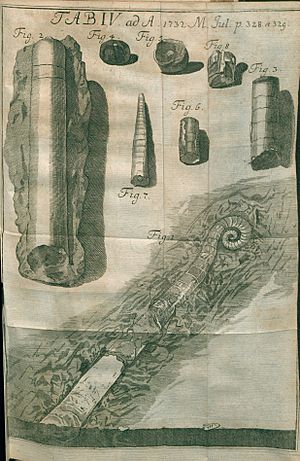Johann Philipp Breyne facts for kids
Johann Philipp Breyne was a very smart scientist born in 1680 in a city called Danzig (which is now Gdańsk, Poland). His father, Jacob Breyne, was also a famous scientist. Johann Philipp grew up to be many things: a botanist (someone who studies plants), a palaeontologist (who studies old fossils), a zoologist (who studies animals), and an entomologist (who studies insects).
He is most famous for his work on a special insect called the Polish cochineal (its scientific name is Porphyrophora polonica). This tiny bug was super important a long time ago because it was used to make a bright red dye. Imagine making clothes or paintings with a vibrant red color from an insect!
Because he was so good at science, he became a member of important groups. In 1703, he was chosen to be a Fellow of the Royal Society in London. This was a big deal, like being invited to join a club for the smartest scientists! He also joined the German Academy of Sciences Leopoldina after 1715 and the Societas Litteraria after 1720. He passed away in 1764 in Danzig.
Contents
His Scientific Discoveries
Johann Philipp Breyne spent his life studying the natural world. He wrote many important papers about his findings.
Studying Insects
One of his biggest interests was insects, especially the Polish cochineal.
- He wrote a famous book called Historia naturalis Cocci Radicum Tinctorii quod polonicum vulgo audit in 1731.
- This book was all about the Polish cochineal.
- He described how these insects lived and how they were used to make red dye.
- He even made some corrections to his own work later, showing how dedicated he was to getting things right.
Exploring Plants and Fossils
Breyne also loved plants and old fossils.
- He wrote about rare plants and insects he saw during his travels, like a trip to Italy in 1703.
- He studied strange things like the "Scythian Vegetable Lamb," which was a mythical plant that people thought looked like a lamb.
- He also looked at amber, which is fossilized tree resin. He found a very rare piece of amber with a plant leaf inside it!
Discovering Ancient Animals
One of his most exciting discoveries involved huge bones found in Siberia.
- In 1737, he wrote a letter about these bones.
- He proved that these bones, which people called "mammoth's bones," actually belonged to ancient elephants.
- This was a big step in understanding prehistoric animals!
Working with Others
Johann Philipp Breyne often worked with other scientists.
- He even wrote a paper with Hans Sloane, another famous scientist.
- This paper was about the dangers of eating too many "crab stones" or similar things. People thought these could help with stomach problems, but Breyne and Sloane warned they could cause kidney stones.
Johann Philipp Breyne's work helped us learn a lot about plants, animals, and the history of life on Earth. He was a true pioneer in many fields of science!


